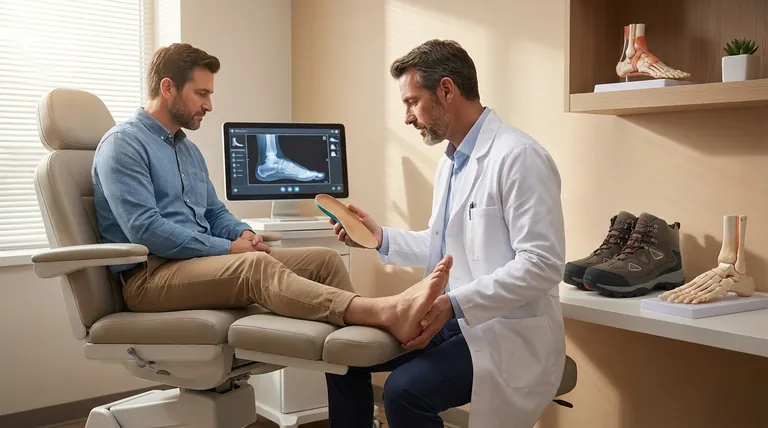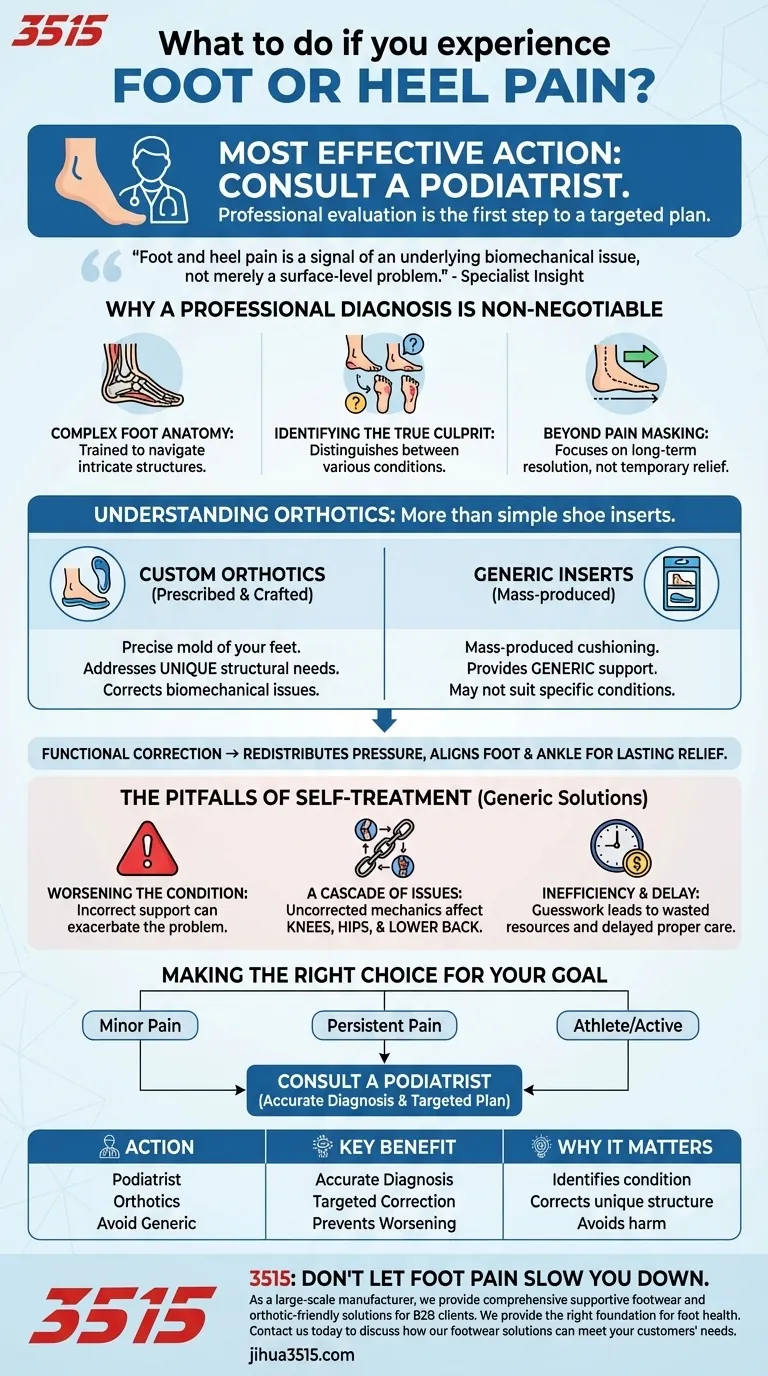For any level of foot or heel pain, the most direct and effective course of action is to consult a podiatrist. A specialist can provide an accurate diagnosis to determine the underlying cause of your discomfort. This professional evaluation is the necessary first step to creating a targeted treatment plan for lasting relief.
Foot and heel pain is a signal of an underlying biomechanical issue, not merely a surface-level problem. Consulting a specialist is critical for diagnosing the root cause and avoiding the pitfalls of ineffective self-treatment.

Why a Professional Diagnosis is Non-Negotiable
Ignoring foot pain or attempting to solve it with generic, off-the-shelf products can often fail to address the core problem. Understanding the "why" behind professional consultation is the first step toward effective treatment.
The Complexity of Foot Anatomy
The human foot is an intricate structure of bones, ligaments, tendons, and muscles. Pain can originate from any of these components due to a wide variety of issues.
A podiatrist is trained to navigate this complexity, distinguishing between different conditions that may present with similar symptoms.
Identifying the True Culprit
Heel and foot pain can stem from numerous conditions, such as plantar fasciitis, Achilles tendonitis, heel spurs, or structural misalignments.
Each of these conditions requires a different therapeutic approach. An accurate diagnosis ensures your treatment directly targets the specific cause of your pain.
Beyond Simple Pain Masking
The goal of a specialist is not just to mask the pain but to correct the underlying mechanical issue causing it.
This approach focuses on long-term resolution and the prevention of recurrence, rather than temporary, symptomatic relief.
Understanding the Role of Orthotics
When a podiatrist is consulted, a common and effective treatment tool is the orthotic. These devices are far more than simple shoe inserts.
What is an Orthotic?
An orthotic is a prescribed medical device designed to correct biomechanical foot issues. It is engineered to control abnormal foot function, provide support, and improve overall body alignment.
The Critical Difference: Custom vs. Generic
A key reason for professional consultation is to determine the appropriate type of orthotic.
Custom orthotics are prescribed and crafted based on a precise mold of your feet, addressing your unique structural needs. Over-the-counter inserts are mass-produced and provide generic cushioning or support, which may not be suitable for your specific condition.
How Orthotics Provide Relief
By redistributing pressure across the foot, supporting the arch, and realigning the foot and ankle, orthotics can alleviate stress on overworked muscles and ligaments. This functional correction is what leads to significant and lasting pain relief.
The Pitfalls of Self-Treatment
In an effort to find a quick fix, many people turn to generic solutions without a proper diagnosis. This approach carries significant risks.
Worsening the Underlying Condition
Using an incorrect type of support can sometimes exacerbate the problem. For example, providing an arch support to a foot that doesn't need it can create new points of pressure and pain.
A Cascade of Issues
Uncorrected foot mechanics don't just affect the feet. They can lead to compensatory pain and alignment problems in the knees, hips, and lower back over time.
The Inefficiency of Guesswork
Without a diagnosis, choosing an insert is simply guesswork. This can lead to wasted money on ineffective products and, more importantly, a delay in receiving the proper care needed to resolve the issue.
Making the Right Choice for Your Goal
Your strategy should be guided by the nature and severity of your symptoms.
- If you are experiencing minor or infrequent pain: Consulting a podiatrist is the recommended first step to understand the cause and prevent the issue from escalating.
- If your pain is persistent, moderate, or severe: It is critical to see a podiatrist for an immediate and accurate diagnosis to begin a targeted treatment plan.
- If you are an athlete or on your feet all day: Proactively seeking a biomechanical evaluation can help prevent pain by addressing potential issues before they become chronic.
By addressing the root cause instead of just the symptoms, you invest in your long-term mobility and well-being.
Summary Table:
| Action | Key Benefit | Why It Matters |
|---|---|---|
| Consult a Podiatrist | Accurate Diagnosis | Identifies the specific condition (e.g., plantar fasciitis) causing the pain. |
| Get Custom Orthotics | Targeted Biomechanical Correction | Corrects foot alignment and function based on your unique foot structure. |
| Avoid Generic Inserts | Prevents Worsening Condition | Mass-produced supports may not address your specific issue and can cause harm. |
Don't Let Foot Pain Slow You Down
As a large-scale manufacturer, 3515 produces a comprehensive range of supportive footwear and orthotic-friendly solutions for distributors, brand owners, and bulk clients. Our production capabilities encompass all types of shoes and boots designed with proper biomechanics in mind.
We can help you provide the right foundation for foot health.
Contact us today to discuss how our footwear solutions can meet the needs of your customers seeking relief.
Visual Guide

Related Products
- Safety Footwear Wholesale Manufacturer for Custom OEM/ODM Production
- Wholesale Safety Footwear Manufacturer for Bulk & Custom OEM Orders
- Wholesale Durable Breathable Safety Boots Custom OEM Manufacturer
- Wholesale Anti-Smash & Puncture-Proof Safety Shoes Custom Manufacturing for Brands
- Comfortable Block Heel Pumps Wholesale & Custom Factory Production
People Also Ask
- What are OSHA approved shoes? Understanding the Correct Standards for Workplace Safety
- What do heavy duty boots do? Protect Your Feet in Demanding Work Environments
- How do safety shoes contribute to cost savings for companies? A Strategic Investment in Risk and Cost Management
- What are the differences between steel toe, composite toe, and alloy toe Wellington boots? Choose the Right Safety Toe for Your Job
- Is it normal to wear shoes in the house? A Guide to Hygiene, Comfort & Culture



















